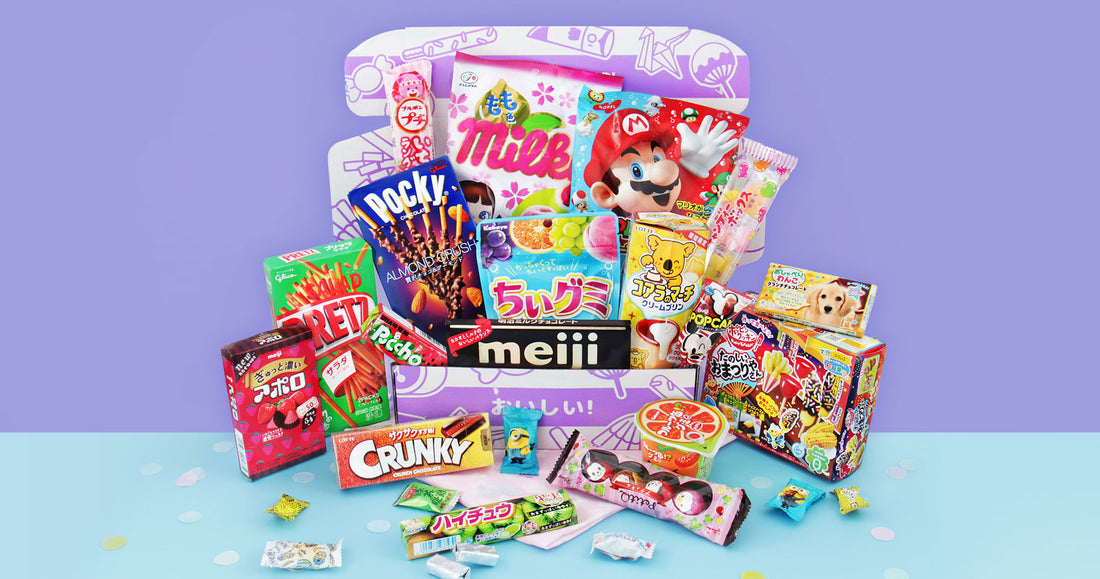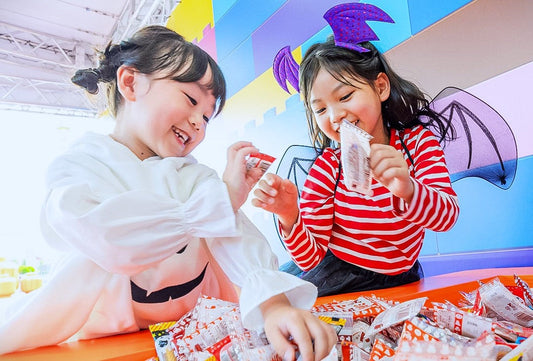Japan is a country that eats with the seasons! Japanese people believe in shun, or the concept of enjoying seasonal ingredients during the height of their freshness and flavor. From September to November, when leaves start turning brown and the air starts getting a little bit chilly, the country offers a ton of tasty Japanese autumn snacks to warm up your belly!
Let's jump right in!
- Yaki Imo (やきいも)
- Kuri (くり)
- Montblanc (モンブラン)
- Nashi (なし)
- Kaki (かき)
- Budou (ぶどう)
- Oden (おでん)
- Kabocha (かぼちゃ)
- Ginnan (ぎんなん)
- Autumn Konbini Snacks
- Autumn Offerings From Food Chains
- Autumn Drinks in Japan

In Japan, people are usually plagued by "shokuyoku no aki" or the "appetite of autumn" during fall. That's because the cooler temperatures of the season make everyone start craving earthy and warm dishes. In Japan, these meals are made from ingredients that are abundant during autumn, like chestnuts, pumpkins, and sweet potatoes. It’s a season filled with culinary delights.
Now that you know that autumn is the season of harvest in Japan, the snacker in you has to wonder. What are the tastiest Japanese autumn snacks, you ask? Put on your favorite coat and grab a picnic basket. We’re going on an adventure to find out! 
1. Yaki Imo (やきいも)

Yaki Imo or grilled sweet potatoes might seem like a simple snack, but their mild flavor and hearty texture are perfect for the chilly weather of autumn. Plus, it's hard not to keep your eyes glued to the yaki imo's beautiful reddish purple hues! Since these sweet potatoes are harvested fresh from late October to November, yaki imo can be especially tasty!
In Japan, there are many different types of sweet potatoes that can be used for yaki imo. There's the Satsuma sweet potato, which is starchy and has a gentle sweetness. The Beni Azuma has bright red or purple skin, a firm texture, and a more subtle sweetness than other sweet potatoes. Brought over from Indonesia, the Ano Imo is a sweet potato variety that has an incredibly sweet taste and rich, sticky texture that makes it perfect for roasting.

Sweet potatoes are so popular in Japan, they’re turned into all sorts of desserts! From sweet potato brulee, sweet potato ice cream, sweet potato drinks, you name it. They make the perfect treat because not only are they tasty but they’re high in fiber, low calorie, and full of all sorts of nutrients!
2. Kuri (くり)

Kuri or chestnuts are a lot different in Japan than in the West. Unlike American chestnuts, which are smaller in size, kuri can grow as large as your hand! They're also boiled rather than roasted, giving them a soft and fleshy texture with a sweet and nutty flavor. Harvested during the fall, kuri is a quintessential flavor of autumn in Japan.

There are so many autumn treats that use kuri. Kurigohan is a dish that mixes chestnuts, rice, soy sauce, sake, mirin, sugar, and salt. If you're looking for something sweet, you can try kuri yokan, a wagashi or traditional Japanese dessert made of agar-agar, smooth red bean paste, and chestnuts. There's also kuri manju, a soft bun with red bean paste filling and a whole chestnut sitting in its center.
Together with satsumaimo or sweet potatoes (another autumn favorite), Japanese chestnuts can also be made into a paste called kuri kinton or chestnut gold mash. This special paste can be eaten on its own or used in dumplings. They can even be used as a flavoring for autumn cakes, mousses, and traditional Japanese treats like dorayaki (a paste-filled Japanese pancake) and kuri anpan (a Japanese sweet bread roll).
3. Montblanc (モンブラン)

Montblanc might be a classic treat that you can find all year round in Japan, but this pastry is always associated with fall. That's because, aside from its cake base that can have various flavors, its biggest feature is strings and strings of kuri chestnut paste falling across the treat. Then, on top of the whole thing is a single chestnut.

In Japan, Mont Blanc can come in many different flavors like matcha and strawberry, but the classic will always be chestnut and sometimes sweet potato. You can find Mont Blanc almost everywhere in Japan, from bakeries to supermarkets to cafes. Sometimes you'll find the stringy Mont Blanc paste served as a topping for ice cream.
4. Nashi (なし)

Nashi or Japanese pears come into season from late August to November. It's a popular treat during fall in Japan! There are so many different varieties of nashi that ripen as autumn progresses. They're sweet, juicy, and oh so refreshing to eat! Not only that, but they're especially rich in dietary fiber, a good source of vitamin C, and very low in calories. Nashi is the perfect autumn treat for people hoping to go on a fall diet!

Most of the time, nashi is best enjoyed fresh by chilling, peeling (optional since a lot of nutrients are in the peel), and slicing them into wedges. However, there are other ways to enjoy nashi! You can steam them with honey and serve them to people with colds as a remedy for a sore throat. You can also serve them in salads and incorporate them in fruit jellies and tarts. Nashi is a versatile autumn treat!
5. Kaki (かき)

Kaki or persimmons are known in Japan as the divine fruit of autumn. They're bright, crisp, and oh sweet. Not only that, but they're really nutritious with fiber, vitamins, tannins, and minerals like Potassium. It's easy to tell when fall arrives in Japan because you can find bright orange kaki or persimmons almost everywhere - from supermarkets, fruit stands, and even restaurant menus.
Most of the time, you can find dried kaki called hoshigaki strung up in food stalls, but you can also find them fresh, stacked up in piles. There are two different types of persimmon in Japan: the hachiya kaki, which is sweet and honeyed in flavor when ripe, and the fuyu kaki, which is crisp and tastes like caramel with a hint of honey.
6. Budou (ぶどう)

Budou or grapes are an autumn fruit in Japan that usually come into season around late August to early September. One of the most popular Japanese autumn grapes is the Shine Muscat, which is large, green, and seedless with a nice mellow sweetness to it. Most of the time, the Shine Muscat is sold as luxury fruit!

Another popular variety is the Kyoho Grape, which is known for its "wine-like" flavor, its juiciness, and the way that you can peel the skin from the fruit. During fall, you'll find a lot of cafe desserts that incorporate the Shine Muscat and Kyoho grapes, from fruit custard tarts, sorbets, and even wagashi or traditional Japanese confectionery.
7. Oden (おでん)

A steaming hot pot filled with savory ingredients simmering in a dashi broth, oden is a light Japanese dish that's super popular during chilly seasons like autumn. Though it's usually considered a winter dish, people start making oden when the air starts getting crisp in September. Not only do families begin cooking it at home during the fall, but konbinis or Japanese convenience stores also start offering oden as well!
Though some people don't think that oden looks as appetizing as other Japanese treats, this hot pot is actually really tasty with a lot of fun ingredients. Some of the most popular ones include daikon radish, which softens as it soaks in the broth, hard-boiled eggs for protein, and chuukawa, a tube-like fish cake. You can also add condiments to your oden, like karashi mustard, miso, and oden sauce made from yuzu.
8. Kabocha (かぼちゃ)

Although kabocha might be a type of winter squash that's available all year in Japan, it actually tastes the best during early summer and late autumn. It's close to butternut squash in flavor, with a deep orange flesh that's soft and sweet when cooked. During the autumn season, you can find street vendors selling kabocha croquettes. Izakaya and tempura restaurants also have pumpkin dishes, like kabocha with ground meat, kabocha no nimono (squash simmered in soy sauce and sugar), and kabocha dango.
9. Ginnan (ぎんなん)

During autumn, Japan's ginkgo trees burst into spectacular gold and their ginnan nuts become a popular seasonal treat in Japan. Though the fruit of the ginkgo tree can be fleshy and foul-smelling, the nuts are another fall favorite treat in Japan. They can be eaten on their own or used in chawanmushi (savory egg custard), takikomi gohan (mixed rice), and in grilled, fried, and stir-fried Japanese dishes.
10. Autumn Konbini Snacks

Of course, since Japan eats with the seasons, it should come as no surprise that Japanese snack and Japanese candy companies come up with limited-edition autumn-only treats. Imagine Kit Kats, Pocky, Tohato Caramel Corn, and a lot of other popular Japanese snack brands offering goodies that taste just like sweet potato, chestnut, and montblanc. Sometimes you can even find Kajyu gummies and Hi-Chew candy that tastes like juicy and refreshing Japanese pear!
That's not all, of course. When fall comes around, konbinis start offering autumn desserts and pastries. Ministop has its limited-edition Mont Blanc soft serve ice cream. Lawson has its Imo-style roll. There's also the 7 Premium Melty Sweet Potato from Seven-Eleven, which is essentially a sweet potato condensed into a small cup. It's a creamy, sweet potato bean taste that's perfect for autumn.
Japan Candy Box is the # 1 choice when it comes to Japanese autumn snacks. We have the tastiest Japanese candy and goodies that you can only find in fall! 
11. Autumn Offerings From Food Chains

In Japan, big food chains tend to follow shun too, offering seasonal, limited-edition treats for people to enjoy. A good example of this would be Starbucks. Every year, Starbucks comes up with autumn drinks and pastries. For 2025, its drink of choice was the Hojicha Scented Yakiimo Mousse Tea Latte which combines both satsumaimo sweet potato and hojicha (roasted green tea).

For fall 2025, McDonald's Japan unveiled a moon-viewing type of menu with sukiyaki hotpot burgers and special sweets. Not only did the fast food chain offer a whole lineup of moon-themed burgers, it also came up with the Shine Muscat Mcshake and the Butter Omochi Tsukimi pie.
12. Autumn Drinks in Japan

Japanese people don't just eat with the seasons; they drink with the seasons as well. When fall comes around, a popular drink of choice is hojicha (ほうじ茶) or roasted green tea. It's the perfect drink to pair with autumn desserts because it's nutty, roasty, and a little bit smoky in flavor. Hojicha has a lower caffeine level compared to matcha, making it a great afternoon pick-me-up!

Another popular drink is Hiyaoroshi sake, which is a seasonal alcoholic beverage made from winter sake that's pasteurized in spring, aged over the summer, and bottled up during fall. Hiyaoroshi sake was created during the Edo period and is still pretty popular today. This drink can be paired with other autumn favorites like chestnuts and pumpkin!

Okay, so we’ve had our fill of all the autumn treats that Japan has to offer! Which Japanese autumn snack are you interested in? Do you want to have a bite of a piping hot yaki imo? Or would you rather take a sip of a special autumn-only Starbucks? Maybe you want to fill up your tummy with some Japanese snacks from the konbini?

Go ahead and don’t be shy! We’d love to know more about your favorite Japanese autumn goodies. After all, good food is worth talking about. Until the next Japanese food trip, see you!






